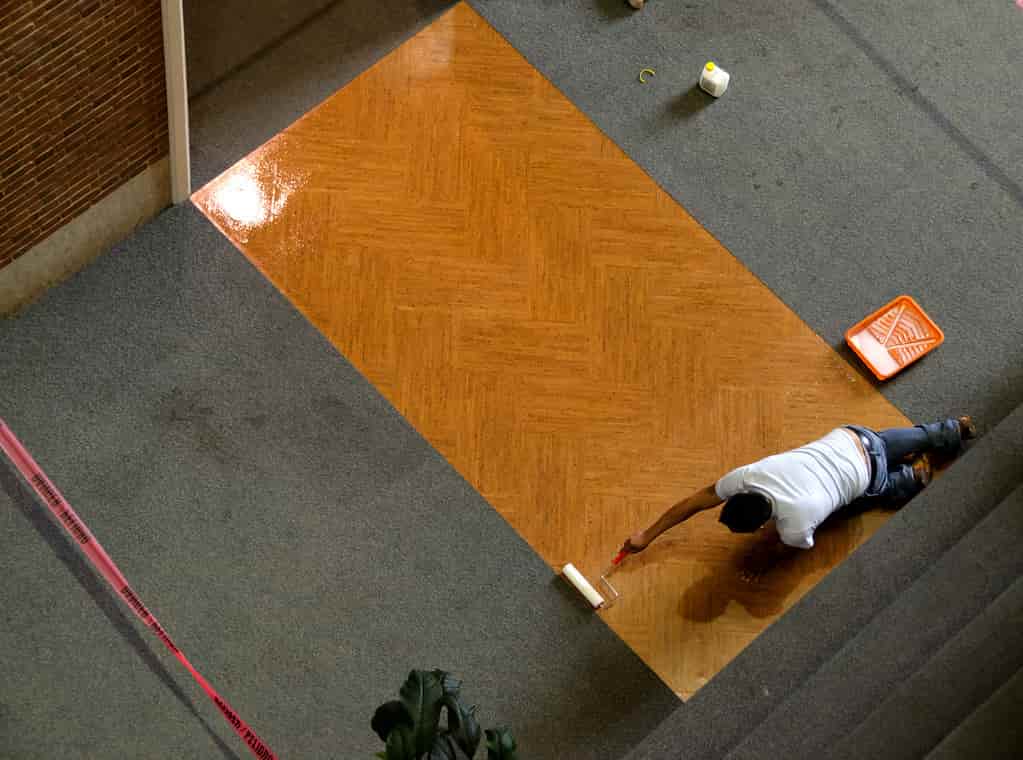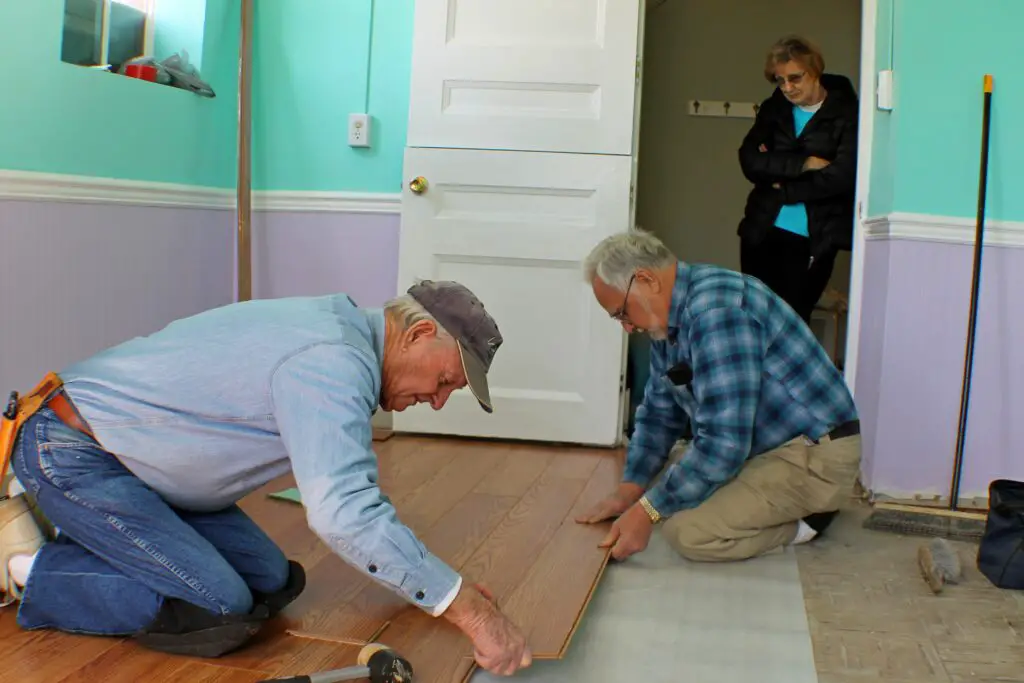No doubt laminate flooring is one of the best choices for householders and it is simple too. Laminate flooring can be installed over hot floors. It is easy to walk on. It is made in such a way that it looks the same as wood floors.
If you do it without any error results are outstanding. You must know the most common mistakes when laying laminate flooring for the best possible results.
Use laminate floor certified to NALFA standard. You can easily avoid the mistakes. Laminate flooring is preferred over hardwoods. Its installation is very easy and less time-consuming.
Use it if you have a plan to sell your house. You can earn a lot of money using this. If you are selling your home and your laminate floor is not properly installed it will definitely create problems for you.
Laminate floors are cheap, can be used in any room, and are easier to maintain. The laminate floor is installed where the floor already exists. Before installation measure your floor.
Buy a sufficient amount of laminate planks for your area. In this blog, we will discuss in detail the most common mistakes when laying a laminate floor.
1. Dampness of Subfloor
Do not use laminate flooring where you see a lot of dampness. It can cause bubbling. Places of dampness are bathrooms and kitchens.
You can install damp protection like a sealant. Laminate flooring contains a core that sucks dampness. It also expands or contracts depending on the dampness. Test your subfloor before installation.
Water-resistant products can be used in highly damp places. When you walk on a damp floor it will feel slippery. Also, level your subfloor before installation. Dampness can cause many problems for you.
It is not good at all for laminate flooring. If you install your floor in a dry area it can still be damaged always remember to seal it. If you see any damaged area during installation fix it soon.
2. Not Sealing the Floor Against Moisture

Sealing your laminate flooring is very important. It does not matter if you are using less damp areas because the possibility of accidents is still there. Must use sealant you can use any type of sealant.
Basically, the laminate floor is highly sensitive to water involvement. Experts never recommend you to use the laminate floor in damp areas but if you wish use enough prevention for a long life. Water involvement in substrate also leads to problems.
3. Not Letting your Laminate Floor Adjust
When you are installing a laminate floor in your home it is important to give the laminate floor its time to adjust before installation. In this way, you can avoid warping.
The floor will also adjust to your home’s moisture level. The time you give to adjust laminate flooring must be 2-3 days. By giving this time the laminate floor will also adjust to the temperature of your home.
If you do not do this be ready for damage. Always remember to do it for the best possible result.
4. Not Making Sure the Floor is Level
Also, ensure that the floor is level before installation. Grinding and self-leveling materials are effective in making the floor level. If you install your subfloor on a surface that is not level it can cause breakage of the floor.
You can check the flatness of the floor using a straight edge. If you find any issue in the flatness fix it first. Your patching compound must dry before installation. You can not use excessive layers of foam to fill patches.
An uneven surface can cause soft spots and soft spot leads to the destruction of your subfloor. The uneven surface also looks wavy.
It’s up to you lever can also help you to make the floor level and one method is to use blue painter’s tape where needed.
5. Not Using an Underlay

Basically, the laminate floor is thin so you can not expect your floor to be flexible or it can bend. Due to floor thinness stress on the floor is very high while you walk on it. It does not feel comfy when you walk on it.
Underlay is a layer of foam and if you use it under your floor you will notice that it acts like a shock absorber and it will absorb any change made in the floor when you walk on it.
After using the underlayment you will feel nice when you walk on it. It’s important for you to choose the right kind of underlayment.
Must use underlayment on your floor. With the help of underlayment, you can also level your floor
6. Not Using a Vapor Barrier
If you are not using a vapor barrier you are making a big mistake in the installation of your laminate floor. Vapor barriers help you to avoid moisture on your subfloor.
If moisture is involved in your subfloor it will definitely cause damage to your floor. Always remember to use a vapor barrier in your installation.
Now question is what is a vapor barrier, it is a thin plastic sheet and you will put it between the subfloor and laminate flooring. Concrete floors are a good example of a floor needing a vapor barrier.
If your vapor barrier also acts as an underlayment then nothing better than that.
One thing you should consider is that if you are installing your laminate floor over a wood subfloor now you can skip the vapor barrier because wood is meant to breathe. A vapor barrier is a must in the case of moisture.
7. Failing to Check the Room
Before installing your laminate flooring, you need to inspect the room and make sure it’s ready for installation. This includes assessing the subfloor for moisture, checking for any cracks or uneven areas that may need to be leveled out, and making sure doorways are adequately cut before laying the planks.
8. Using the Wrong Tools
When installing laminate flooring, you should always use the right tools for the job. This includes a saw to cut planks and a hammer or mallet to secure them in place.
Make sure you have all the necessary tools before getting started so that your installation goes smoothly without any unnecessary hiccups.
9. Not Pre-Drilling Holes for Nails
When nailing down laminate planks, it’s important to pre-drill holes before hammering in the nails. This helps ensure a more secure fit and prevents the plank from cracking or splitting. Use a drill bit that is slightly smaller than the diameter of the nail to ensure a tight fit.
10. Not Using Adhesive Properly
The adhesive is essential for keeping your laminate planks securely in place, especially on stairs and tight corners. But it’s important to use the right type of adhesive and apply it correctly to get a secure fit.
11. Not Leaving Space for Edge Expansion
Always leave space around the edges of the wall to avoid any kind of damage. Laminate flooring is made in a way that it floats and from this, you can say that the pieces of your laminate floor that interlock move together and they do not move one by one.
When you walk on your floor it can move a little bit. You can not cut your laminate floor very tight to the wall. Leave space for every installation of the subfloor.
With the help of this, you can avoid buckling. Another issue is that if you are nailing your quarter round in your floor with the help of laminate you do not use baseboard.
In this way, your floor has no chance to make a change in it.
Alignment of your planks is also a thing to notice for proper installation. For example, if you cut one end of the board then it should be aligned with the other end. Use glue when installing corners to get perfection in the installation.
12. Inadequate Door Clearance
It’s critical to ensure that there is enough clearance for doors, both at the bottom and the sides, to prevent scraping or jamming on the laminate floor once installed.
An insufficient door clearance might require additional work, as it often involves removing the door to trim its bottom edge or alter the door jamb which can be a complex and time-consuming task.
To avoid this, before installing the laminate floor, check the clearance of all doors that open into or out of the room. If they don’t have enough clearance, it’s advisable to trim the doors or jambs prior to the floor installation, ensuring smooth operation post-installation.
13. Using the Wrong Tools
The use of inappropriate tools while installing laminate flooring can not only slow down the project but also potentially damage the material, causing unnecessary expense and delays.
Proper equipment such as a laminate cutter, pull bars, tapping blocks, and quality underlayment tape can greatly facilitate the process and ensure a professional finish.
A laminate cutter, for example, can make precise, clean cuts, preventing chipping or splitting of the laminate layers. Pull bars and tapping blocks are used to fit the planks together without damaging the locking system.
Employing the right tools is a vital aspect that should not be overlooked to ensure a successful and efficient laminate flooring installation.
14. Not Planning Transitions
Neglecting to plan for transitions between different types of flooring can result in an unsightly and potentially hazardous finish.
Transitions are not just about the aesthetic appeal, but they also serve important functional purposes such as accommodating for expansion and contraction of the flooring material.
For instance, T-molding at doorways or where the laminate meets another type of flooring material allows for the movement of laminate due to natural expansion and contraction, thereby preventing buckling or gaps.
Use transition strips that match your laminate flooring for a smooth, harmonious flow between rooms. Ensure you measure accurately and cut precisely for a professional, seamless look.
Always remember, that proper planning of transitions is crucial for a successful flooring installation, contributing to the durability, functionality, and aesthetics of your floor.
15. Not Follow instructions carefully
You can say that laminate flooring and its installation process are quite similar but laminate flooring is available in different designs.
So different designs need different processes of installation. It is important for you to read the instructions carefully before installation.
Not doing this will cause many problems for you. Always read instructions for the best possible result. Instruction covers the best method of installation. You should know the proper amount of adhesive used for the installation of laminate planks.
Bottom Line
There you have it, eight of the most common mistakes made when laying laminate flooring. By avoiding these mistakes, you can be sure that your laminate floor will look great and last for many years to come.
If you can avoid these pitfalls, you’ll be on your way to enjoying beautiful, long-lasting floors. Just remember to take your time, prep the surface properly, and use the right materials, and you’ll be sure to end up with floors you love.
So next time you’re thinking about redoing your floor, be sure to keep these tips in mind.
And if you’re still not sure, there’s no shame in calling in a professional to help you out. After all, your floor is one of the most important parts of your home – it’s worth getting it right.
FAQ
Why does my laminate floor keep separating?
The most common reason for floorboards separating is temperature. Whenever there is a rise in temperature it will become the reason for floorboard expansion. However, some high-quality laminate flooring materials are temperature-resistant.
Why is my new laminate floor lifting?
Access to incorrect expansion joints is the biggest and most common reason for laminate floor lifting. Whenever, feel floor lifting you first check this. 8 to 10mm of expansion on all sides of the floor is recommended by the laminate flooring experts.
Do you cut the tongue off the first row of laminate?
To avoid the expansion gap issues, it is recommended to cut off the tongue on the first row. Then make an angle to press the short ends together you need to insert the second plank into the first.


3 thoughts on “15 Common Mistakes When Laying Laminate Flooring”